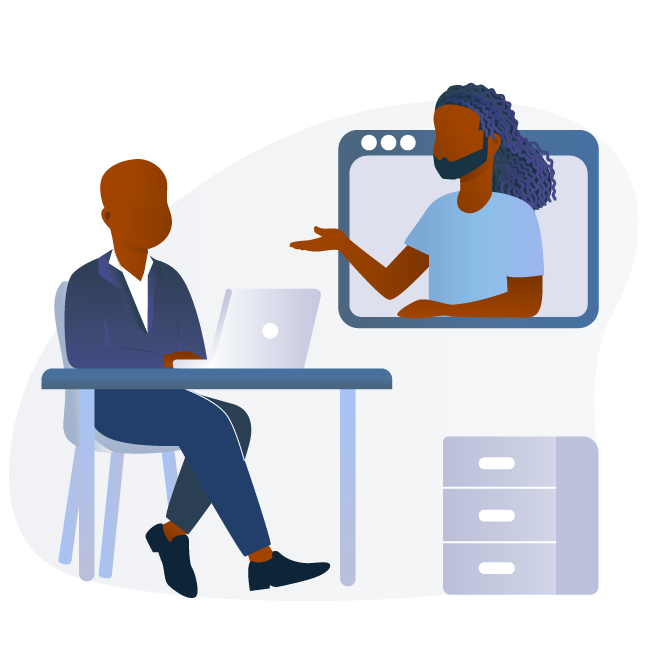What is CBL?
Case-Based Learning (CBL) is an active, small-group learning environment that uses a clinical case to prompt inquiry and exploration of core clinical and scientific concepts while developing clinical reasoning skills in a structured manner. With the guidance of faculty facilitators and collaboration with peers, you’ll explore various core concepts that integrate the clinical and foundational sciences while considering contextual factors that impact patient care and outcomes.
Why CBL?
Adults come to a learning situation with pre-existing knowledge, skills, beliefs, and concepts that affect what they pay attention to and how they organize, interpret, and retrieve information. New knowledge and understanding are constructed in relation to what a person already knows and believes. By applying the following educational principles, CBL helps medical students build a bridge between what they already know and what they need to know to reach the next level. How?
Active learning is more effective and satisfying. It enhances retention and recall more than passive teacher-to-student learning. It emphasizes student-centered learning in which students are actively involved in setting their own learning goals.
CBL enables students to learn science and clinical concepts as they apply knowledge to a specific patient whom they meet in the case. This improves the ability to retrieve information and focuses on important concepts/prototypes/frameworks, which helps learners organize and store new information that facilitates retrieval and application.
Students explore prior knowledge, formulate inquires, and actively construct meaning through dialogue and reflection. Problems are designed and presented to simulate students’ perception of their future profession, which serves as a powerful stimulus for students’ motivation to learn.
In small groups, students develop a community of learners who meet regularly over a period of time and engage in collaborative problem-solving (building on each other’s knowledge), practice skills of professionalism, learn to use appropriate evidence-based literature, and practice giving and receiving feedback. By actively involving students in monitoring their progress, they can reflect on what works and what needs improvement.
CBL learning objectives
(relevant to every case, every week)
-
Demonstrate respectful, constructive, adaptive interactions with peers and/or facilitators, including punctual attendance, advanced preparation, professionalism, and giving and receiving feedback.
-
Identify knowledge gaps, pursue answers, and integrate concepts into group discussions.
-
Demonstrate an organized approach to clinical reasoning, referencing scientific evidence when discussing clinical scenarios.
-
Construct a prioritized list of plausible diagnoses, based on clinical and biomedical sciences, as well as hypothesis-driven history, examination, and clinical investigations.
-
Propose disease management and treatment strategies, including health promotion activities, taking into consideration culture, preferences, social determinants of health and equity, and ethical frameworks to address potential barriers to health care.
Case-specific learning objectives are uploaded to E.Flo MD each week and can also be found in the case.
How CBL fits into the overall curriculum
Clinical cases form the backbone of the first two years of the ESFCOM curriculum where each week leads with a clinical case that serves as an anchor for learning. The list of cases has been selected to cover a broad base of medical education during the first two years of the curriculum. These cases are intended to link basic science concepts with clinical concepts, develop clinical reasoning, and promote contextualization of patient care as it relates to societal challenges, health care disparities, health systems, and ethics.
Roles and responsibilities
The ultimate goal of a CBL facilitator is to help students become self-directed learners. This is accomplished through:
- Fostering a student-centered, small-group, learning environment through guided facilitation of core concepts and clinical decision reasoning by collaboration and consensus.
- Providing feedback through redirection or inquiry.
- Management of group dynamics to encourage an active, respectful, and collaborative learning environment where all students feel comfortable participating.
- Assessment of students for strengths and areas for growth through in-person meetings and formal Work Based Assessment (WBA) rubrics.
CBL facilitators are process experts who help students develop skills needed for self-directed and collaborative learning. While facilitators must be familiar with the case content to successfully guide students, they are not content experts.
- Read the case preview prior to the Monday session.
- Collaboratively participate in group discussions by hypothesizing, asking questions, and identifying learning gaps as related to the case.
- Arrive at each session prepared to discuss all group learning issues and case questions with appropriate citations from a variety of literature sources.
- Actively collaborate in the completion of group assignments and learning goals.
- Actively contribute to effective group dynamics and effective conflict resolution.
- Engage colleagues in a respectful, collaborative and professional manner.
- Give and receive feedback to peers and faculty a professional manner.
A typical week in CBL
small-group session.
Year 1: Facilitated.
Year 2: Self-guided.
small-group session.
Need help?
-
Can't find the case for the week or having trouble accessing it?
Contact medicine.tech@wsu.edu or medicine.cbl@wsu.edu. For more help, check out the MedTech iBooks page.
-
Need help navigating the case?
Here is a handy guide.
-
Technology issue?
Contact medicine.tech@wsu.edu or message medtech-help on Slack.
-
Confusion about the CBL calendar (small-group sessions)?
Contact medicine.cbl@wsu.edu.
-
Need help locating a library resource?
Contact the Health Sciences Library.
